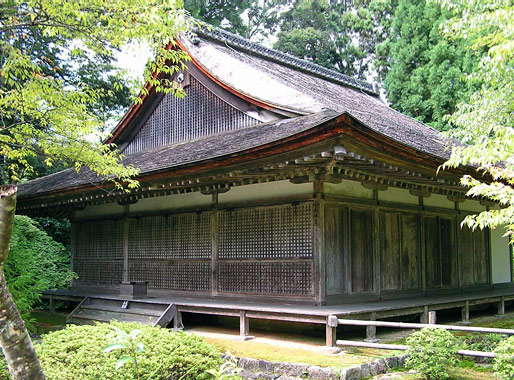|
||
 |
||

Jingoji Nouryoubou 神護寺納涼房 (Kyoto)
(C)2001 Japanese Architecture and Art Net Users System. No reproduction or republication without written permission.
掲載のテキスト・写真・イラストなど、全てのコンテンツの無断複製・転載を禁じます。
|
||||||
| daishidou 大師堂 | ||||||
| KEY WORD : architecture / buildings & structures | ||||||
| Lit. great master hall. Daishidou are temple buildings particularly important to the Shingon 真言 sect, established by *Kuukai 空海 (774-835, posthumously named *Koubou Daishi 弘法大師). However, there are some daishidou at temples belonging to the Tendai 天台 sect, established in Japan by Saichou 最澄 (767-822; posthumously called Dengyou Daishi 傳教大師). Both sects use the term daishi 大師 meaning Great Master. There are seven extant daishidou six of which have been designated as important cultural properties. They can be found at Jingoji 神護寺, also called *Nouryoubou 納涼房 (Momoyama period) in Kyoto; Ookuraji 大蔵寺 (Kamakura period) in Nara; Negoroji 根来寺 (1391) in Wakayama prefecture; Shitennouji Ganzan 四天寺元山, formerly known as Shiidera Fumon-in 椎寺普門院 (1623) in Osaka; Honganji 本願寺 (1636) in Kyoto; Onjouji 園城寺 (1598) in Shiga prefecture, and Shinchougokuji 新長谷寺 (Muromachi period) in Gifu prefecture. Four of the Daishidou have boat-shaped bracket arms *funahijiki 舟肘木, two have 3-on-1 non-projecting bracket arms *mitsudo tokyou 三斗斗きょう, and one building has 1-stepped bracket complexes *degumi 出組. All the daishidou except Negoroji have double eaves *futanoki 二軒. Closely spaced rafters are used at Ookuraji, Negoroji, Honganji and Shitennouji Ganzan. Two locations have hipped roofs *yosemune-zukuri 寄棟造, three are pyramidal *hougyou-zukuri 宝形造 and two have hipped-and-gabled roofs *irimoya-zukuri 入母屋造. Three halls have tiled roofing *hongawarabuki 本瓦葺. Other roofs have thinly cut, thickly layered wood shingles or cypress bark shingles *hiwadabuki 桧皮葺. | ||||||
 Jingoji Nouryoubou 神護寺納涼房 (Kyoto)
|
||||||
| REFERENCES: | ||||||
| EXTERNAL LINKS: | ||||||
| NOTES: | ||||||
(C)2001 Japanese Architecture and Art Net Users System. No reproduction or republication without written permission. 掲載のテキスト・写真・イラストなど、全てのコンテンツの無断複製・転載を禁じます。 |
||||||